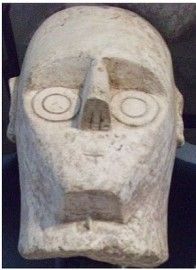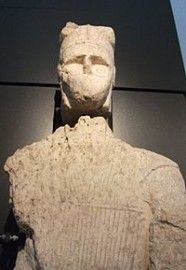 In Homer’s Odyssey – composed around the XI century BC – we encounter in the X chapter the Laestrygonians, horrendous flesh heating giants who, by throwing stones from a cliff, destroy Odysseus’s fleet. According to the calculations made by Victor Bérard (1864 – 1931) the Laestrygonians were living in Northern Sardinia or Southern Corsica. I am here for the first time putting forward the hypothesis that instead of Northern Sardinia, Odysseus might have landed in Western Sardinia – in today’s province of Oristano, around Marina di Torre Grande – an area inhabited since neolithic times and rich in cliffs and coves, similar to that described in the Odyssey.
In Homer’s Odyssey – composed around the XI century BC – we encounter in the X chapter the Laestrygonians, horrendous flesh heating giants who, by throwing stones from a cliff, destroy Odysseus’s fleet. According to the calculations made by Victor Bérard (1864 – 1931) the Laestrygonians were living in Northern Sardinia or Southern Corsica. I am here for the first time putting forward the hypothesis that instead of Northern Sardinia, Odysseus might have landed in Western Sardinia – in today’s province of Oristano, around Marina di Torre Grande – an area inhabited since neolithic times and rich in cliffs and coves, similar to that described in the Odyssey.
Here is the Translation of part of the X chapter of the Odyssey by Samuel Butler. “Thence we sailed sadly on till the men were worn out with long and fruitless rowing, for there was no longer any wind to help them. Six days, night and day did we toil, and on the seventh day we reached the rocky stronghold of Lamus- Telepylus, the city of the Laestrygonians, where the shepherd who is driving in his sheep and goats [to be milked] salutes him who is driving out his flock [to feed] and this last answers the salute. In that country a man who could do without sleep might earn double wages, one as a herdsman of cattle, and another as a shepherd, for they work much the same by night as they do by day. “When we reached the harbour we found it land-locked under steep cliffs, with a narrow entrance between two headlands. My captains took all their ships inside, and made them fast close to one another, for there was never so much as a breath of wind inside, but it was always dead calm. I kept my own ship outside, and moored it to a rock at the very end of the point; then I climbed a high rock to reconnoitre, but could see no sign neither of man nor cattle, only some smoke rising from the ground. So I sent two of my company with an attendant to find out what sort of people the inhabitants were. The men when they got on shore followed a level road by which the people draw their firewood from the mountains into the town, till presently they met a young woman who had come outside to fetch water, and who was daughter to a Laestrygonian named Antiphates. She was going to the fountain Artacia from which the people bring in their water, and when my men had come close up to her, they asked her who the king of that country might be, and over what kind of people he ruled; so she directed them to her father’s house, but when they got there they found his wife to be a giantess as huge as a mountain, and they were horrified at the sight of her. She at once called her husband Antiphates from the place of assembly, and forthwith he set about killing my men. He snatched up one of them, and began to make his dinner off him then and there, whereon the other two ran back to the ships as fast as ever they could. But Antiphates raised a hue and cry after them, and thousands of sturdy Laestrygonians sprang up from every quarter- ogres, not men. They threw vast rocks at us from the cliffs as though they had been mere stones, and I heard the horrid sound of the ships crunching up against one another, and the death cries of my men, as the Laestrygonians speared them like fishes and took them home to eat them. While they were thus killing my men within the harbour I drew my sword, cut the cable of my own ship, and told my men to row with alf their might if they too would not fare like the rest; so they laid out for their lives, and we were thankful enough when we got into open water out of reach of the rocks they hurled at us. As for the others there was not one of them left. I am basing my assumption on a great find made in March 1974 by a farmer at Mount Prama. He had his plough’s blade damaged by a fragment of a large stone surfacing in his field. The stone showed mysterious carvings and archeologists called on the spot discovered under the ground more than 450 similar large fragments. The news was briefly reported on the Sardinian press but no national newspaper or agency reported it. Those fragments were then transported to a museum in Cagliari and were left there for 29 years, almost forgotten. Only in 2003 – because of pressure put by archeologists – the fragments were sent to a laboratory in Sassari where restoration work begun. Once the pieces were put together appeared giants human figure of a kind never seen before. Archeologists are now back on the spot at Mount Prama with sophisticated instruments which seem to have revealed a sort of buried city underground. These impressive sculptures are between two hundred and two hundred-sixty centimetres tall, carved in sandstone and with a distinctive oriental look. They represent archers, boxers, athletes and they were placed on raised platforms lining up the road which was leading from the Campidan to the old port. Their exact dating has not been yet established but there is an agreement that they do belong to the Nuragic period, dating from 3000 to 4000 years ago and, as such, they are the oldest statues of the Western Mediterranean. They may have be so impressively arraigned in order to awe visitors coming from the Etruscan confederation in central Italy, from North Africa and Greece. According to Roberto Narni, the archaeologist who managed to reassemble thousand of fragments and shreds, the giants of Mount Prama were systematically smashed around the IX – VIII century BC possibly by an invading army. It is possible that the impression made by these fierce-looking stone giants on Greek sailors may have inspired the legend of the Laestrygonians, a story which might have been inserted into the Odyssey. 

